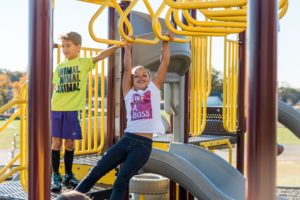Playground Safety Tips
Inspect your playground and maintain it, too, on a regular basis. Make sure that it is safe for the kids. Doing this simple task can help prevent many playground injuries.
- Check playground equipment for hazards such as loose bolts, wood splinters, sharp edges and protrusion hazards
- Make sure swing seats are not cracked and that the chains or ropes are in good condition.
- Make sure you have properly installed surfaces under and around equipment; this helps decrease the likelihood of fall injuries occurring.
- Did you know that the fall zone of any play structure should be six feet in all directions? This means it is less likely kids will fall on unprotected surfaces.
- Also, make sure the kids know that if they see anything such as broken glass as they are playing to let the person in charge know so it can be picked up.
 Supervise children of all ages on the playground. Make sure they are playing nice but also safe, too. Don’t allow too many kids on one piece of equipment at a time and make sure they aren’t pushing swings too high either. Encourage children to follow playground rules and play safely with each other. That means no shoving, crowding and pushing.
Supervise children of all ages on the playground. Make sure they are playing nice but also safe, too. Don’t allow too many kids on one piece of equipment at a time and make sure they aren’t pushing swings too high either. Encourage children to follow playground rules and play safely with each other. That means no shoving, crowding and pushing.
Check for safe playground surfacing. The IPA recommends avoiding playgrounds with non-impact absorbing surfaces, such as asphalt, concrete, grass, dirt or gravel. Ensure that there is safe, ADA accessible surfacing beneath and surrounding playground equipment. Shock absorbing surfaces include rubber, grass, sand, wood chips or synthetic turf.
(Click each picture to enlarge.)
Use age appropriate equipment. Children develop differently and have different confidence levels, too. Make sure they are playing on equipment that is appropriate for their age and development level. For instance, spring-loaded seesaws are great for young children but adjustable seesaws with chains can crush their small hands.
Check the temperature of playground equipment, such as steel slides. Some playground equipment can get excessively hot or cold in extreme temperatures.
Practice how to fall safely such as a tuck and roll or how to break a fall with the knees or elbows.
Dress appropriately for playground play. This does mean weather appropriate clothing, too; however, it’s also about not wearing clothes that can get caught in playground equipment. For instance, no hoodies with drawstrings. Make sure kids are wearing the right shoes – no sandals or flip flops or open-toed shoes.
Article: How to Keep Your Child Safe on the Playground.
 Need help with playground maintenance or safety inspections?
Need help with playground maintenance or safety inspections?
Pat McNamara is a Certified Playground Safety Inspector by the National Recreation and Park Association.
Call: 434-664-8522
Email: Pat McNamara





